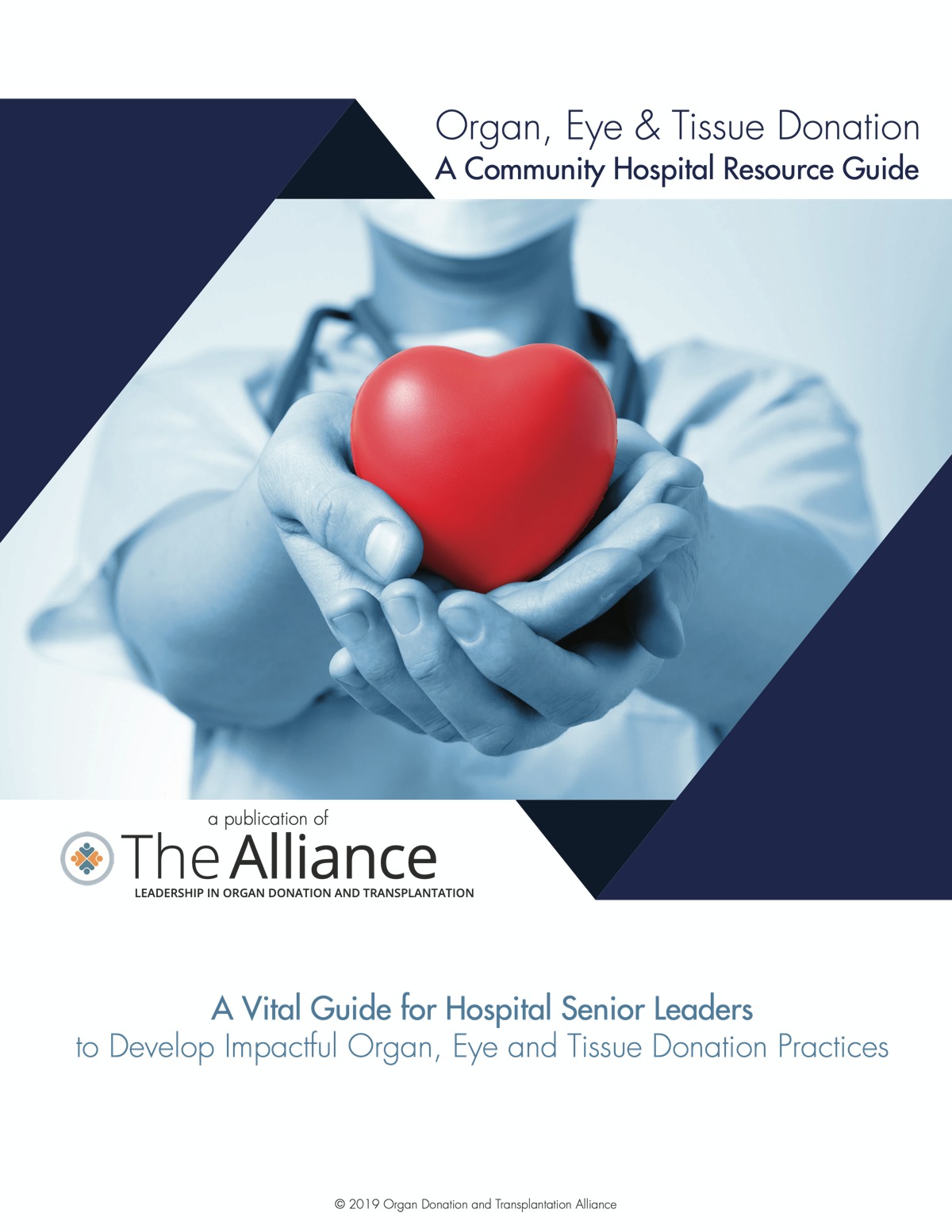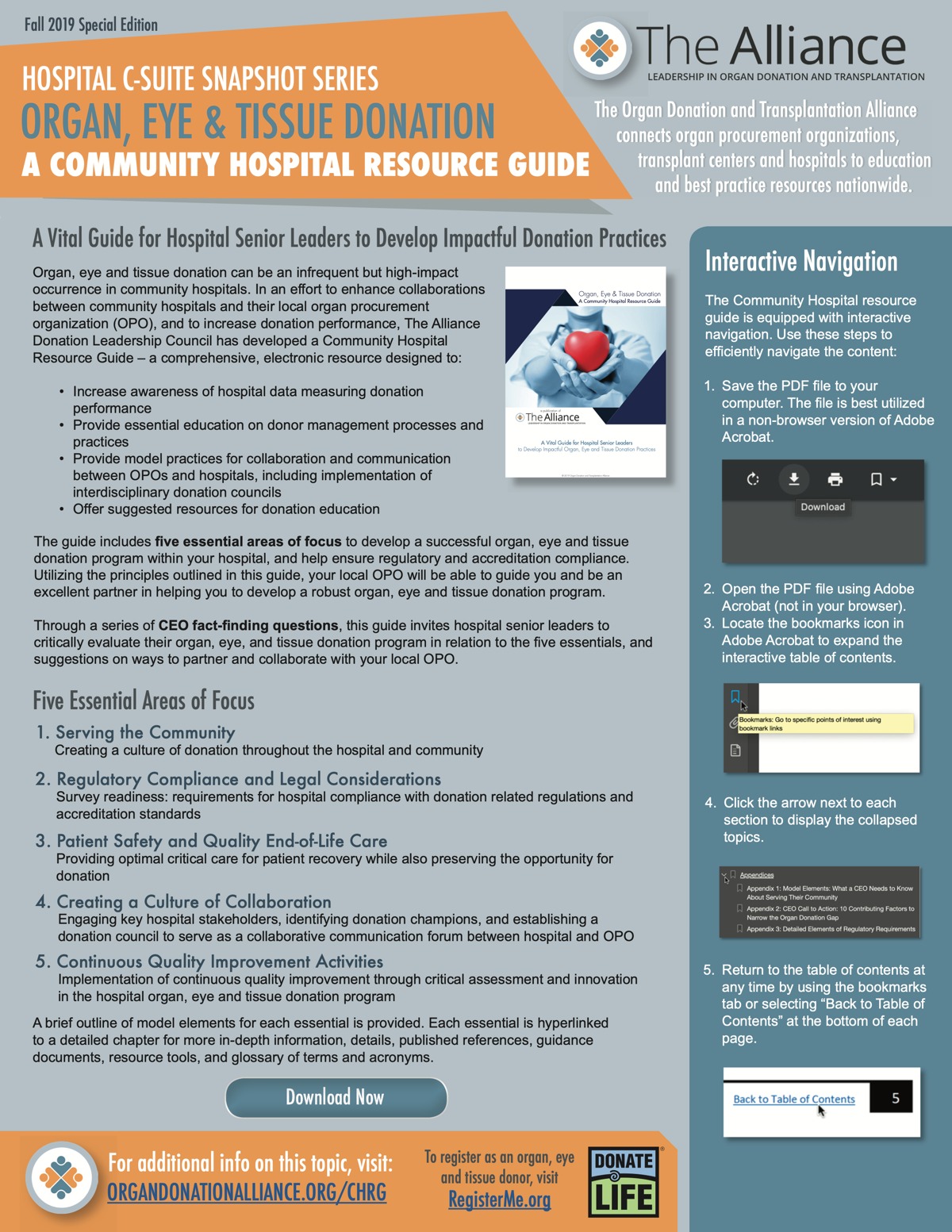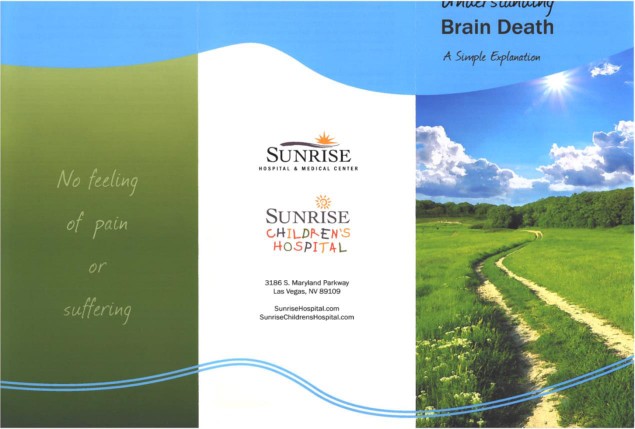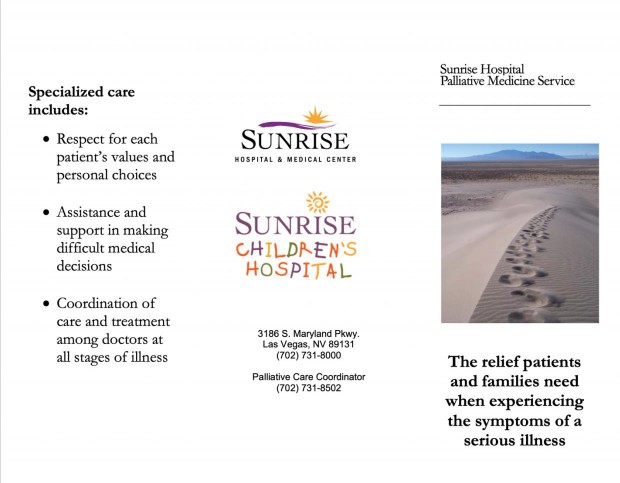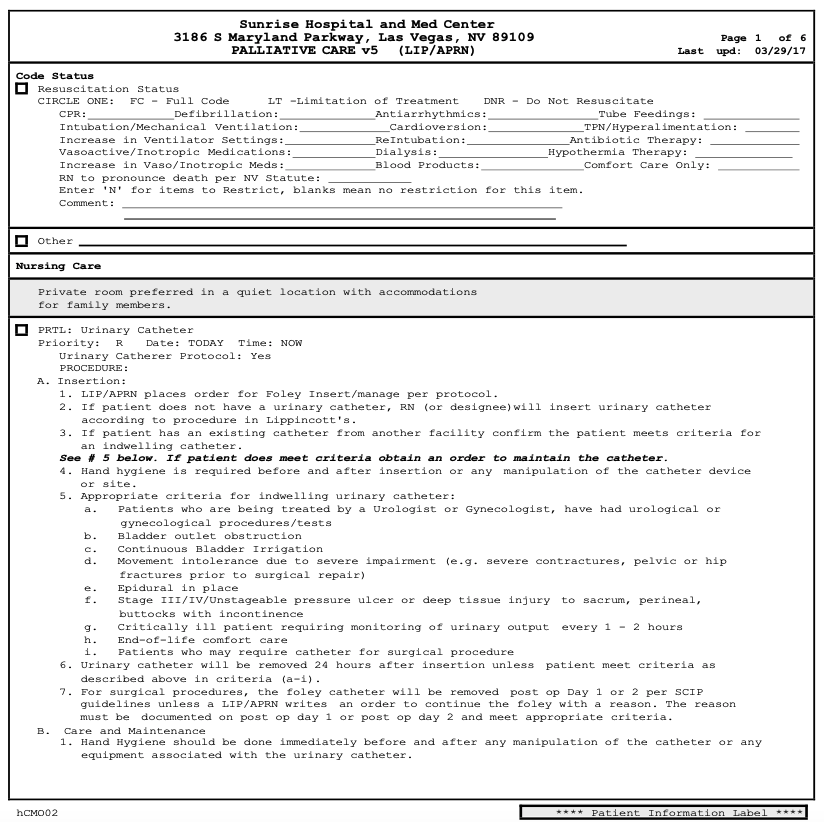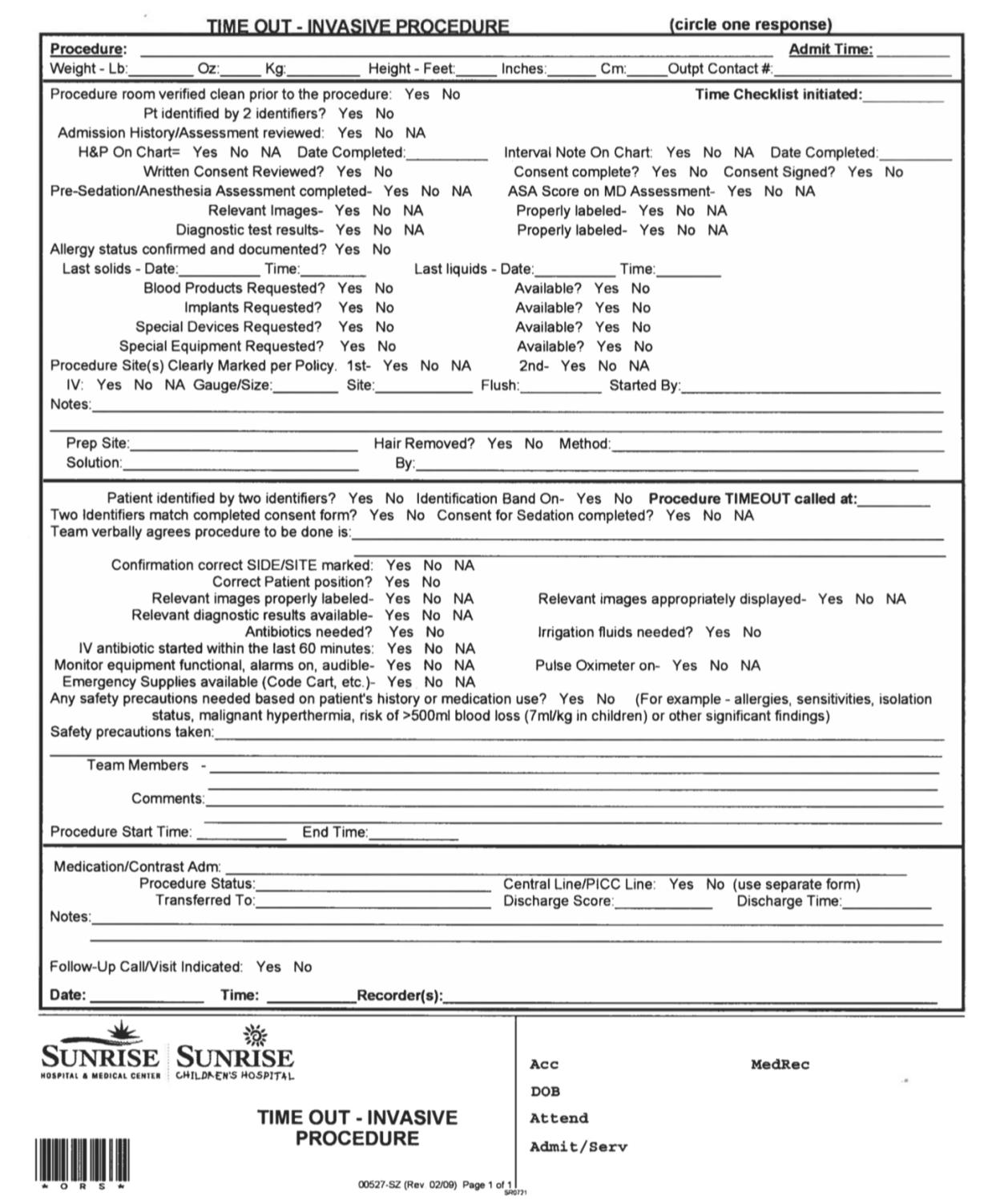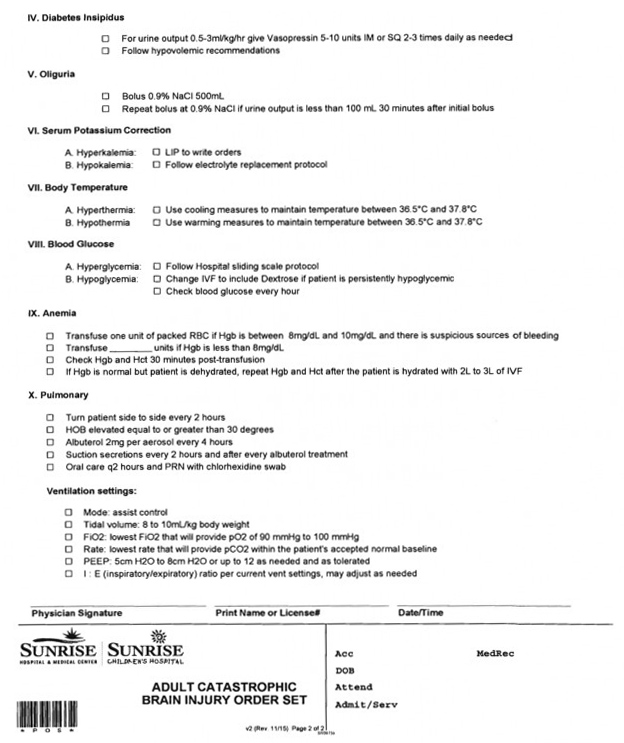Community Hospital
Resource Guide
A Vital Guide for Hospital Senior Leaders to Develop Impactful Organ, Eye and Tissue Donation Practices
Table of Contents
A Community Hospital Resource Guide
For linking to the Community Resource Toolbox, the Community Hospital Resource Guide and Transplant Quality Resources Guide and Tools, please use the following disclaimers:
Community Resource Toolbox Disclaimer:
The Community Resource Toolbox includes a variety of resources created, collected, and/or compiled by the Organ Donation and Transplantation Alliance. (Insert name of your organization) is neither affiliated with nor endorsed by the Alliance and claims no ownership in any of the Community Resource Toolbox materials. By clicking this link, you will be directed to the Alliance’s website located at https://www.organdonationalliance.org//resources/toolbox/.
Please use the Alliance logo on your website. Link here to locate and download a version of the logo that best suits your site:
Transplant Resource Guide (TRG) Disclaimer:
The Transplant Resource Guide (TRG) includes a variety of resources created, collected, and/or compiled by the Organ Donation and Transplantation Alliance. (Insert name of your organization) is neither affiliated with nor endorsed by the Alliance and claims no ownership in any of the Transplant Resource Guide (TRG) materials. By clicking this link, you will be directed to the Alliance’s website located at https://www.organdonationalliance.org/resources/transplant-resource-guide/.
Please use the Alliance logo on your website. Link here to locate and download a version of the logo that best suits your site:
Community Hospital Resource Guide Disclaimer:
The Community Hospital Resource Guide includes a variety of resources created, collected, and/or compiled by the Organ Donation and Transplantation Alliance. (Insert name of your organization) is neither affiliated with nor endorsed by the Alliance and claims no ownership in any of the Community Hospital Resource Guide materials. By clicking this link, you will be directed to the Alliance’s website located at https://www.organdonationalliance.org/resources/community-hospital-resource-guide/.
Please use the Alliance logo on your website. Link here to locate and download a version of the logo that best suits your site:
The Alliance Resource Section
Essential 3
Patient Safety and Quality End-of-Life Care
This essential highlights the necessity for optimal critical care to protect the patient’s safety and create the best environment for patient recovery, while also preserving the opportunity for donation. If a patient will not survive, quality end-of-life care should include the choice of organ, eye, and tissue donation to be presented and honored if the patient meets medical criteria for donation.
Fact Finding Questions CEOs May Ask of Their Senior Leadership:
- Did your unit experience any decelerations in care or delays in diagnosis of brain death last year?
- What has your team done to maximize every organ donation opportunity?
- Are end-of-life protocols compatible with opportunities for organ donation?
- How are we collaborating with the OPO to ensure operating room (OR) availability in a timely manner for organ recovery cases? (if OPO does not have a recovery facility)
Model Elements for Patient Safety and Quality End-of-Life Care
Detailed Components of Patient Safety and Quality End-of-Life Care
- Recommend following American Academy of Neurologist (AAN) and American Academy of Pediatrics (AAP) guidelines – provided by OPO and included in hospital policies.
- Highlight AAN and AAP differences.
- Consistent practitioners to perform brain death testing – consider educational competency.
- Develop brain death and donation pamphlets.
- Track adherence to hospital policy for pronouncement and documentation (OPO Death Record Review (DRR) and bi-annual review).
- Palliative care/support services education and monitoring programs – especially about end-oflife care.
- Plan interdisciplinary huddle (with OPO) prior to medical teams introducing end of life care questions to the patient’s decision-makers. 8. Recommend needed time-out prior to withdrawal of care.
Tools and Resources
-
- Neuro Critical Care Society: Brain Death Toolkit
- Cleveland Clinic – Death by Neurological Criteria (DNC) Course
(Requires account creation > Search “(DNC) 07/01/19) - Alliance Resource Toolbox – Neurologic Determination of Death
- Alliance Spotlight Series – Brain Death Pronouncement (Vol III, Issue 8)
- The Joint Commission: Transplant Safety Standards
- Brain Death Pamphlet (Example)
- Palliative Care Pamphlet (Example)
- Compassionate Withdrawal Order Set Example
- Time-Out: Invasive Procedure (Example)
- Adult Catastrophic Brain Injury Order Set (Example)
- Helpful Hints for Patient Transfer for DCD
- Patient Safety – Quality Improvement Modules. Josie King Foundation
- Brain Death. American Academy of Neurology
- American Academy of Neurology. Update: Determining Brain Death in Adults. AAN Clinician Guideline Supplement. 2010
- Documentation of brain death. American Academy of Neurology
- Brain Death. American Academy of Pediatrics
- Nakagawa TA, Ashwal S, Mathur M, et al. Clinical Report – Guidelines for the Determination of Brain Death in Infants and Children: An Update of the 1987 Task Force Recommendations. American Academy of Pediatrics Clinical Report
PATIENT SAFETY
Organ, eye, and tissue donation is an infrequent opportunity with high impact, and because of the many variables in the donation process, an infrastructure to support the donation process is critical to coordinating donation and maintaining public trust.
Recommendations:
-
- Timely referral of potential donors based on clinical triggers
- Early involvement of the OPO
- Elements of patient safety culture:
- Starts at the top o Visibility to staff
- Core value of institution
- Tied to organizational goals
- Performance measurement
- Transparency
- Promotes communication
- Promotes trust
- Transparent with staff and families
- Deviation to hospital donation policies and missed opportunities RCA, QAPI
- Supplying optimal critical care, maintaining the opportunity for donation
- Death Pronouncement
- Recommend following the American Academy of Neurology (AAN) and American Academy of Pediatrics (AAP) death pronouncement guidelines. Both should be addressed in hospital policies. (links to AAN and AAP)
- Consistent practitioners performing neurologic death (brain death) testing.
- Timely diagnosis of brain death
- Address types of training and simulation
- The use of information technology systems that support electronic sharing of information between OPOs and hospitals will eliminate errors and create efficiencies in the organ donation process.
Palliative care services are available in two thirds of hospitals in the United States and the demand continues to grow. In instances where palliative care services have yet to be implemented, the task of providing patient and family support generally falls to social work and spiritual services departments.
Recommendations:
-
- Early involvement of Palliative care
- Effective OPO collaboration with palliative care team to identify potential donor patients, and to create effective communication strategies whereby there is uniform messaging to family
- Palliative Care and OPO Shared Values:
- Patient and family-centered decision-making
- Communication between healthcare teams, patients, and families
- Emotional support for patients and families
- Symptom management and comfort care
- Spiritual support for patients and families
- Organizational and emotional support for ICU clinicians
- Palliative care additional important roles:
- Provide support to families during brain death assessment
- Ensure clinical care for patients undergoing donation after circulatory death (DCD)
- Provide support for patients and families during withdrawal of life-sustaining treatments (WOLST)
- Collaborative communication with the family of potential donor; challenging communications with family or healthcare providers
- Palliative care can help with the transition of care to end-of-life care
- Can help to optimize the approach to the family
- Work directly with OPO to discuss issues of family dynamics, understanding of medical facts, to ensure there is no ambiguity with patient’s goals
- Donation after Circulatory Death (DCD)
Palliative care services can support the DCD process by partnering with the OPO in the critical care environment- Staff education o Defining standards for end-of-life care with DCD
- Communication and family support o Coordination of care
- Comprehensive medical management
- Expert clinical end-of-life care, regardless of donation outcome
- Expert symptom management during withdrawal of life-sustaining treatment.
- Transfer of Donation of Circulatory Death (DCD) patients in faith-based facilities
Community Hospitals without palliative care would require education on basic principles of organ donation and providing opportunity to collaborate with the OPO as well as with other hospital team members including social workers and chaplaincy.
Helpful Hints for Patient Transfer for DCD
Donation after circulatory death (DCD) is a possibility that can be considered in cases where a patient has a nonrecoverable and irreversible neurological illness and is ventilator dependent, and the decision is made by the patient or more often the patient’s surrogate decision maker to remove respiratory support. Many times, a patient will have a catastrophic intracerebral event with no hope of recovery but with some minimal neurological function. Other times a patient will have a severe underlying illness (musculoskeletal, pulmonary disease, high spinal cord injury), that has caused ventilator dependence and precludes any meaningful quality of life. CMS and accrediting bodies require hospitals to address asystolic organ recovery.
- Determine an accepting provider. This may or may not be the pronouncing provider.
- Determine if the family will be present for the compassionate extubation and where the location will be.
- When authorization is obtained for DCD, this is the ideal time to obtain the consent to withdraw care if required by facility or state regulations. In addition, if the family is not going to be at bedside, the accepting facility will need to contact family to obtain permission for withdrawal of care. Again, the recommendation is that this consent can be obtained at the same time the donor consents are obtained with the PTC or FSC calling the accepting facility to obtain verbal permission or if needed fax the consent to the sending facility. Using the palliative care team is beneficial as the OPO usually has the direct line and the PC team may be able to aid in obtaining the verbal consent.
- If the patient will have family in attendance, please prepare a quiet place away from the rest of the patients. Prepare the area with chairs, water, tissue, Chaplain/Spiritual Support as requested by family and any other items that the facility has available for comfort.
- Before the compassionate extubation a prayer may be offered. Remind the family that there will be little time for final goodbyes after the patient has died. Although the family has been prepared for the information, it is helpful to reinforce the timeline.
- Have a provider order compassionate extubation (see resource list for example). The recommendation is to extubate to room air. For those facilities without PC teams, this may be a new process.
- It is important to determine what staff from the accepting facility will be part of the process. Unlike the internal donor where the patient comes from a bed and usually accompanied by the assigned nurse, the transfer patient will be accompanied by a nurse and the surgical staff will have to perform this responsibility. There should be education regarding expectations.
For more tools and resources on DCD please visit The Alliance Community Resource Toolbox.




